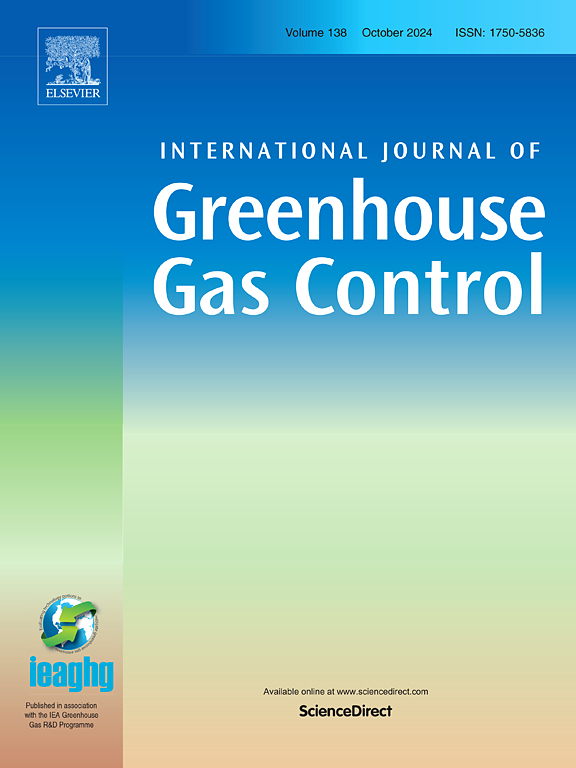Flow2Quake是一个集成多相流、地质力学和地震活动性模型,用于有效预测注入和抽取引起的地震
IF 5.2
3区 工程技术
Q2 ENERGY & FUELS
International Journal of Greenhouse Gas Control
Pub Date : 2025-05-28
DOI:10.1016/j.ijggc.2025.104388
引用次数: 0
摘要
能源部门的安全和脱碳努力正在推动各种地下油藏的开发。这些操作有诱发地表变形和地震的危险。为了评估这些风险,需要综合流体流动、地质力学和地震活动建模的建模工具。在这里,我们展示了在流体提取或注入配置下的变形和地震活动建模的综合框架中使用有效的垂直流动平衡(VFE)多相流体流动模型。vfe计算的时空压力演化被输入到地质力学模块中,以计算储层内部和周围的地表变形和应力变化。应力变化为地震活动模块提供数据,以计算地震概率。首先,我们将基准模型应用于格罗宁根的天然气开采。在那里,我们可以在保持计算效率的同时,将压力测量的方差减少到先前存在的单相流模型的38%。地表变形和地震活动性模拟结果与观测数据吻合较好。其次,我们研究了Decatur一期项目中二氧化碳封存引起的诱发地震活动。我们发现,对于Decatur一期项目,孔隙弹性应力变化可以解释建模不确定性范围内的大部分非聚集性观测地震活动。最后,我们使用Quest字段模拟CO2封存的场景。倾斜的储层地形显著影响CO2羽流的预测位置,但对地质力学变形(和地震活动性)的影响很小。将VFE模型与地质力学和地震活动预测结合起来,可以实现实时危害评估和缓解程序。本文章由计算机程序翻译,如有差异,请以英文原文为准。
Flow2Quake, an integrated multiphase flow, geomechanical and seismicity model for efficient forecasting of injection and extraction induced earthquakes
Efforts to secure and decarbonize the energy sector are driving various subsurface reservoir operations. These operations carry a risk of inducing surface deformation and earthquakes. To assess these risks, modeling tools integrating fluid flow, geomechanical and seismicity modeling are needed. Here, we demonstrate the use of an efficient Vertical Flow Equilibrium (VFE) multiphase fluid flow model in an integrated framework for deformation and seismicity modeling both under fluid extraction or injection configurations. The VFE-computed spatio-temporal pressure evolution is fed to a geomechanical module to compute surface deformation and stress changes in and around the reservoir. Stress changes feed a seismicity module to calculate earthquake probabilities. First, we apply the benchmarked model to gas extraction from Groningen. There, we can reduce the variance of pressure measurements by 38% with respect to a pre-existing single phase flow model while remaining computationally efficient. The surface deformation and seismicity simulations show remarkable agreement with observed data. Second, we study induced seismicity due to CO sequestration in the Decatur phase 1 project. We find that, for the Decatur phase 1 project, poroelastic stress changes can account for most of the non-clustered observed seismicity within modeling uncertainties. Finally we simulate scenarios for CO sequestration using the Quest field. The sloping reservoir topography significantly impacts the predicted position of the CO plume but the effects on geomechanical deformation (and seismicity) are minimal. Incorporating VFE models with geomechanical and seismicity forecasts with real-world case applications can allow real-time hazard assessment and mitigation procedures.
求助全文
通过发布文献求助,成功后即可免费获取论文全文。
去求助
来源期刊
CiteScore
9.20
自引率
10.30%
发文量
199
审稿时长
4.8 months
期刊介绍:
The International Journal of Greenhouse Gas Control is a peer reviewed journal focusing on scientific and engineering developments in greenhouse gas control through capture and storage at large stationary emitters in the power sector and in other major resource, manufacturing and production industries. The Journal covers all greenhouse gas emissions within the power and industrial sectors, and comprises both technical and non-technical related literature in one volume. Original research, review and comments papers are included.

 求助内容:
求助内容: 应助结果提醒方式:
应助结果提醒方式:


